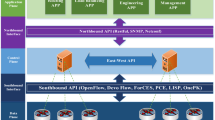Abstract
Predicting the correct traffic matrix is crucial in addressing many network issues like routing, availability of networks, clear communication, etc.… In conventional networks, link load measurements are used for better traffic matrix prediction. The precision of a system, however, is small since this method does not evaluate the fundamental series of linear equations governing the problem of traffic prediction. Software-Defined Networks(SDN) offer statistics of certain forms of movements, thus providing different ways of solving issues with the traffic matrix. A network’s performance and complexity can be measured using SDN. In this research work, a deep traffic matrix prediction model is proposed to evaluate the traffic in a better way. Further, the network traffic can be forecasted by using the traffic knowledge of a particular network. Gradient descent is considered to be an iterative machine learning modeling method that helps in reducing errors, optimizing weights, and thereby lowering the cost function. Evaluating the gradient of the negative likelihood equation in calculating the traffic matrix is a challenging part since all state models are composed of the gradient. In the traffic matrix, some methods deliver correct predictions, and some do not. In the proposed work, we have introduced two algorithms, the sparse PLSR and Run-2-Run algorithms for traffic prediction. A comparative study between the proposed algorithms and the already existing algorithms was done based on the training efficiency and performance in traffic prediction.
Access this chapter
Tax calculation will be finalised at checkout
Purchases are for personal use only
Similar content being viewed by others
References
Xie J, et al (2018) A survey of machine learning techniques applied to software defined networking (SDN): research issues and challenges. IEEE Commun Surv & Tutor 21(1):393–430
Fadlullah ZMd, et al (2018) On intelligent traffic control for large-scale heterogeneous networks: a value matrix-based deep learning approach. IEEE Commun Lett 22(12):2479–2482
Nie L, et al (2016) Traffic matrix prediction and estimation based on deep learning for data center networks. IEEE Globecom Workshops (GC Wkshps)
Gongming W, et al (2017) Nonlinear system identification using deep belief network based on PLSR. In: Proceedings of 36th Chinese control conference (CCC). IEEE
Tian Y, Chen W, Lea C-T (2018) An SDN-based traffic matrix estimation framework. IEEE Trans Netw Serv Manage 15(4):1435–1445
Hantouti H, et al (2018) Traffic steering for service function chaining. IEEE Commun Surv & Tutor 21(1):487–507
Yang, Senyan, et al. (2017) Ensemble learning for short-term traffic prediction based on gradient boosting machine. J SensS
Camacho J, et al (2019) Semi-supervised multivariate statistical network monitoring for learning security threats. IEEE Trans Inf Forensics Secur 14(8):2179–2189
Fei LI, Xiaoguang GAO, Kaifang WAN (2018) Training restricted boltzmann machine using gradient fixing based algorithm. Chin J Electron 27(4):694–703
Zhang C, et al (2018) Citywide cellular traffic prediction based on densely connected convolutional neural networks. IEEE Commun Lett 22(8):1656–1659
Nie L, et al (2018) Network traffic prediction based on deep belief network and spatiotemporal compressive sensing in wireless mesh backbone networks. Wirel Commun Mob Comput
Zhao J, et al (2019) Spatiotemporal traffic matrix prediction: a deep learning approach with wavelet multiscale analysis. Trans Emerg Telecommun Technol 30(12):e3640
Bellie V, Gopal MK, Venugopal G (2020) Using machine learning techniques towards predicting the number of dengue deaths in India—A case study. Int J Eng Trends Technol (Special Issue):130–135
Gopal MK, Bellie V, Venugopal G (2020) A novel machine learning technique towards predicting the sale of washing machines in a small organization. Int J Psychosoc Rehab 24(5):6969–6976
Gopal MK, Amirthavalli M (2019) Applying machine learning techniques to predict the maintainability of open source software. Int J Eng Adv Technol 8(5S3):192–195
Gopal MK, Venugopal G, Amirthavalli M, Meenaskhi Sundaram B (2021) A recommendation model for cultivating crops using machine learning. In: Proceedings of the Northeast Green Summit 2021, National Institute of Technology, Silchar, 16–18 November 2021
Author information
Authors and Affiliations
Corresponding author
Editor information
Editors and Affiliations
Rights and permissions
Copyright information
© 2022 The Author(s), under exclusive license to Springer Nature Singapore Pte Ltd.
About this paper
Cite this paper
Gopal, M.K., Amirthavalli, M., Meenakshi Sundaram, B. (2022). Improved Sparse PLSR and Run-To-Run Algorithms for Traffic Matrix Prediction in Software-Defined Networks. In: Marriwala, N., Tripathi, C.C., Jain, S., Mathapathi, S. (eds) Emergent Converging Technologies and Biomedical Systems . Lecture Notes in Electrical Engineering, vol 841. Springer, Singapore. https://doi.org/10.1007/978-981-16-8774-7_19
Download citation
DOI: https://doi.org/10.1007/978-981-16-8774-7_19
Published:
Publisher Name: Springer, Singapore
Print ISBN: 978-981-16-8773-0
Online ISBN: 978-981-16-8774-7
eBook Packages: EngineeringEngineering (R0)




